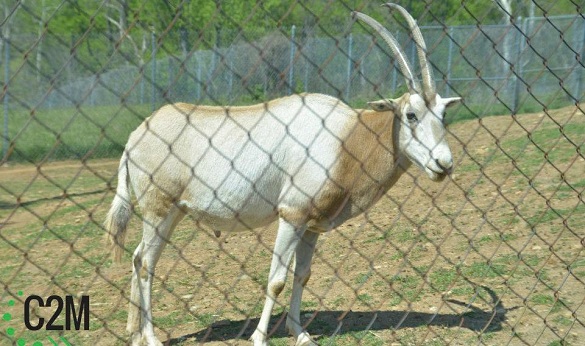Mason's Front Royal conservation site expanding, offers tours to students
The Smithsonian-Mason Global Conservation Studies Program is expanding in the fall to include two separate semester programs for undergraduates at the Smithsonian Conservation Biology Institute (SCBI) in Front Royal, VA.
With a new program effectively doubling the amount of semester slots available for undergraduates, from 20 to 40, administration decided to begin offering Mason students tours of the institute this spring.
"We decided to drive interest by bringing students to the facility and giving them a flavor of the place," said Alonso Aguirre, executive director of the Smithsonian-Mason School of Conservation. "Being at the facility changes your mind on whether or not you want to come here."
To accommodate the expanding programs, a new dorm building, dining facility, and academic center are being constructed at the SCBI site in Front Royal. That project began last summer and the new facilities are now scheduled to open for the start of the Fall 2012 semester.
The tours offered by the SCBI this semester are designed to give students a broad overview of programs and a chance to observe some of the institute's endangered animals, which include red pandas, clouded leopards, cheetahs, white-naped cranes and several wild horse species.
Members of the C2M staff attended a scheduled tour on Friday, April 13. At that time, a total of five tours had been conducted since the start of the spring semester.
Since the SCBI is a private government-run conservation facility, the institute is not open to the public, except for one full weekend in October.
The two programs offered for undergraduate students are Applied Conservation Strategies and, new for the Fall 2012 semester, Ecology for Effective Conservation Practices. Both programs are 16-credits, combining five courses with a hands-on practicum experience. SCBI also currently offers a total of seven graduate classes.
“The hope is that over the next couple of years that number will grow to 15-20 graduate programs,” said Stephanie Lessard-Pilon, faculty member at the Smithsonian Conservation Biology Institute.
In previous semesters, the institute has only been able to house about 20 students each semester. The new dorm building will now offer bed space for over 100 students and visiting faculty.
Students who live and study at the Front Royal facility are granted access to some of the 3,200 acres of private government conservation property and are able to interact and assist research tasks with the institute’s many endangered species.
“You get really informed about how conservation works in the real world,” said Lessard-Pilon.
According to Lessard-Pilon, the Applied Conservation Studies program enables students to complete a minor degree in just one semester at the Front Royal institute and has drawn students from many universities and disciplines. She estimates that half of the students accepted into the program each semester are non-Mason students.
Participants in the program have come from as far as the University of California Davis and from a long list of major programs including biology, economics, business, global affairs and political science.
Jennifer Buff, also a faculty member at the institute, said the true living and learning communities, with students living on the conservation site with their fellow students, is one of the ways the program is especially unique.
“It’s like a semester abroad, only you don’t need a passport," said Buff.
Students interested in one of the undergraduate or graduate programs at SCBI can find more information and apply online at http://mccs.gmu.edu/.
A brief history of the SCBI in Front Royal

A horned oryx observes tour guests at the SCBI on April 13 (Jake McLernon).
Posie Beam is a volunteer tour guide at the SCBI and led one of the tours organized for Mason students on April 13. She began the tour by explaining some of the property’s early history, dating back shortly after the Civil War.
According to Beam, the Front Royal facility began at that time as a remount depot for breeding and conditioning horses for Army use. Thousands of stallions were bred and shipped off for service use during World War I and several of the horses that survived the war were buried full body on the Front Royal site.
With diminishing need for military horses, Beam said the land was used as a prisoner of war camp and canine unit during World War II. In 1948, following the war, the camp was shut down and became a beef cattle research facility until the 1960’s when the Smithsonian Institute discovered the land and planned its use as a conservation site.
The land was officially declared a Smithsonian Conservation Center in 1973 and remained a conservation facility until a brief scare in 2001 when then Secretary of the Smithsonian Institution Lawrence Small decided to close the conservation center. Beam said Small's decision was met by strong opposition and ultimately he withdrew the proposal.
In 2008, the Smithsonian Institution began an informal partnership with Mason, performing undergraduate conservation training. In 2010, an official partnership between the institutions was established with the launching of the SCBI on Jan. 25 that year.
Today, the institute is home to a multitude of conservation projects and provides a safe environment for animal species without a natural habitat. Much of the research conducted at SCBI focuses on the recovery of endangered animal species and their habits.
Check out our Facebook album with additional photos from C2M's visit to the SCBI on April 13.
